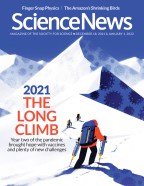Readers ask about the Milky Way’s newfound ‘feather’, CT scan safety and more
- More than 2 years ago
Fine feather
A filament of cold, dense gas named the Gangotri wave may bridge two spiral arms near the Milky Way’s center, Lisa Grossman reported in “Scientists find the Milky Way’s first known ‘feather’ ” (SN: 12/18/21 & 1/1/22, p. 4).
Reader Doug Holcomb asked how this newfound “feather” differs from a galactic spur.
The language describing the different limbs of the Milky Way can get fuzzy, Grossman says. In general, our galaxy has four primary spiral arms emanating from its center, and an unknown number of smaller arms. A spur tends to be an offshoot of an arm, but the line between spur and arm is not so strict.
“The main difference between the Gangotri wave and other galactic tendrils is that Gangotri runs perpendicular to the larger arms of the galaxy, and crosses two of them,” Grossman says. “That crossing of the two arms is unique, although researchers expect that there are probably more of them throughout the Milky Way that have yet to be discovered.”
Reader Jasmine Melvin wondered whether the Gangotri wave has stars.
“Many regions within the wave are sites of active star formation,” says astrophysicist Veena V.S. of the Max Planck Institute for Radio Astronomy in Germany. Future studies are needed to characterize the total number of stars within the structure, she says.
Carbon curiosity
Massive stars with an orbiting partner star shed on average about twice as much carbon as loner stars do, Ken Croswell reported in “How stars turn into carbon factories” (SN: 12/18/21 & 1/1/22, p. 12).
When a massive star with a partner explodes, its carbon is cast into space, Croswell reported. On the other hand, a single star’s core would have destroyed much of its carbon before such an explosion. Reader Bill Camenga wanted to know what becomes of the carbon in single stars.
“The carbon doesn’t just vanish,” Croswell says. During a single star’s life, most of its carbon gets transformed into oxygen. When the star explodes, that oxygen is cast into space, helping make oxygen the third most abundant element in the universe after hydrogen and helium. The exact nuclear reaction, he says, is carbon-12 + helium-4 → oxygen-16 + energy.
You asked for it
A new mathematical equation describes bird eggs of all shapes found in nature, and it could have applications in conservation and agricultural research, Rachel Crowell reported in “Elusive equation describes all bird eggs” (SN: 12/4/21, p. 11). Several readers have asked to see the eggcellent equation, shown below in its full glory.

B = Egg maximum breadth
L = Egg length
w = The distance between two vertical axes corresponding to the maximum breadth and the midpoint of the egg’s length
DL/4 = Egg diameter at the point that’s a quarter of the egg length away from the egg’s pointed end
x = A number of points between −L/2 and L/2
X-ray! X-ray! Read all about it!
In 1971, the first X-ray CT scan of a patient provided an unprecedented image of the human brain. Fifty years later, CT scans are still saving lives and helping researchers better understand the world around us, Emily Conover reported in “Celebrating 50 years of CT scans” (SN: 12/18/21 & 1/1/22, p. 44).
Several readers wondered whether radiation from CT scans should be a concern for those receiving them.
Scientists have continually improved CT technology over the years, not only making it faster and higher resolution, but also decreasing the amount of radiation that people receive, Conover says. Although CT scans typically expose patients to more radiation than standard X-ray imaging, the amount of radiation from one scan is still relatively small. Depending on the type of CT scan, the radiation received may be less than the average background radiation a person gets from various sources in the environment over a year, she says.
There is still debate among scientists about the potential health effects of such low doses of radiation, Conover says. When a doctor orders a CT scan, they typically will have determined that the benefit to the patient outweighs the small risk.
Correction
In “Pointed takedown of the mammoth hunters” (SN: 1/15/22, p. 22), archaeologist Vance Holliday of the University of Arizona in Tucson, not Vance Haynes, weighed in on archaeologist Metin Eren’s hypothesis that ancient Clovis points were not used for hunting the tusked beasts.
